- The Inventory

Support Quartz
Fund next-gen business journalism with $10 a month
Free Newsletters
With over 440 expected dead, the Yangtze river cruise sinking is China’s worst boating disaster
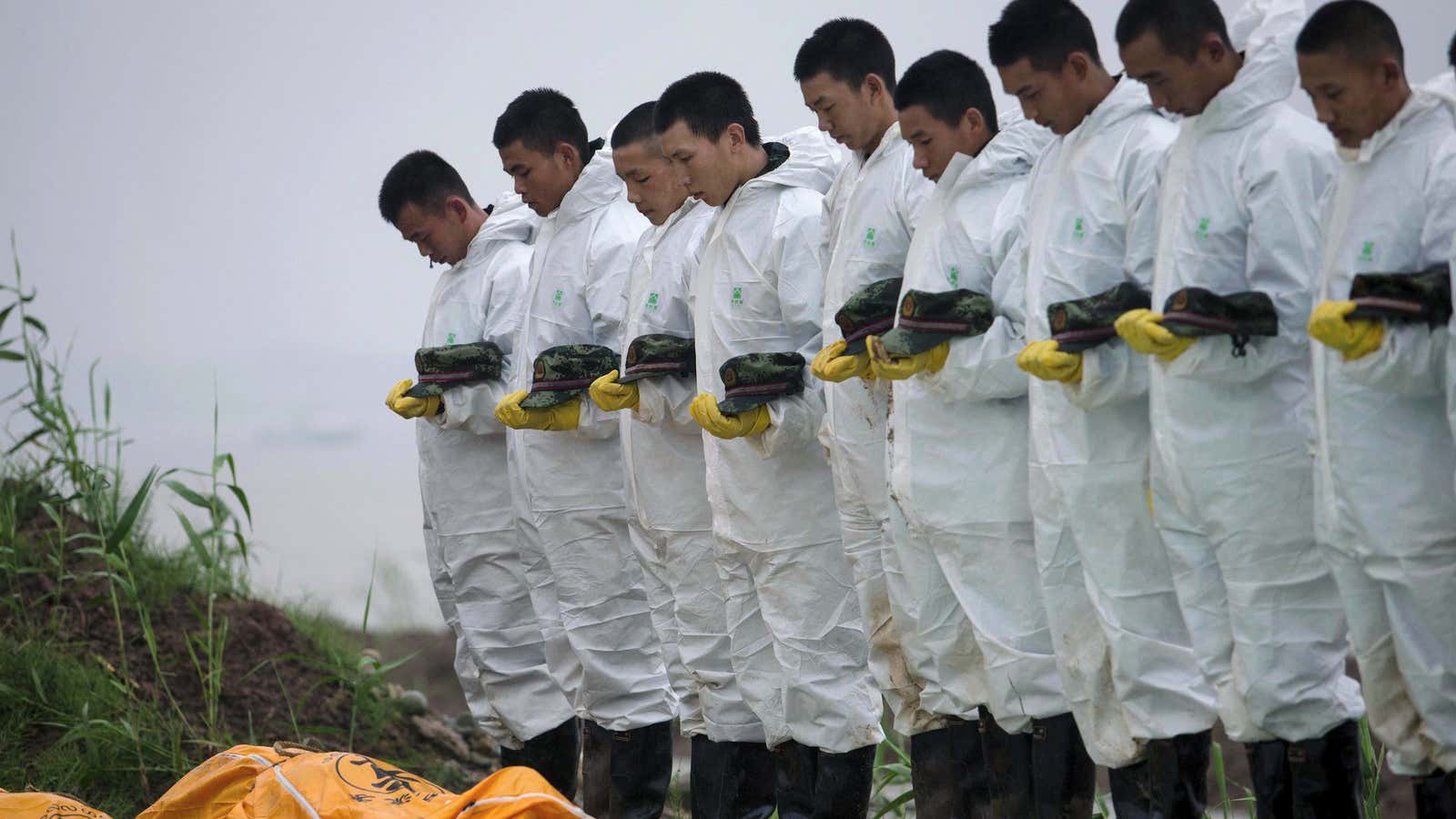
Chinese rescuers do not expect to find any more survivors from a capsized cruise boat on the Yangtze River. The death toll is expected to reach over 440 people, which makes the sinking the deadliest maritime incident during peacetime in China’s history.
On Friday, emergency responders righted the overturned Eastern Star yacht that had been floating in the river in Hubei province since Monday evening, after sinking during a storm. Rescuers had initially heard voices of those trapped inside from the overturned hull of the ship, but only 14 people out of 456 passengers on board have been rescued. So far, 97 bodies have been recovered.
Rescuers had been carefully cutting holes into the hull, afraid of causing the ship to lose buoyancy and sink further , Chinese officials said. They had delayed righting the ship in hopes of extricating more survivors. On Thursday, China’s transport ministry spokesman said that the “overall judgment is that there is no chance of people being alive.”
The last time China experienced as many casualties in a maritime incident was at the tail end of the civil war between the communists and nationalists. In January 1949, a steamboat of Chinese refugees fleeing the mainland for Taiwan sank, killing over 1500 people. In 1999, 280 people were killed when their ferry in the Bohai bay in northeastern China caught fire and capsized.
The accident is China’s worst maritime disaster not just for its death toll. Attempts at empathy from government officials have come off orchestrated and stilted , and propaganda authorities have ordered Chinese media to focus on the “positive part” of the story, while censoring online discussion and questions about the rescue effort.
The relatives of passengers on board, many of them elderly tourists, are growing angrier by the day at a lack of answers from the government. Some say they have been beaten by police for asking for information. Chinese officials have been slow to explain why the boat continued into a storm when other vessels heeded weather warnings and stopped. An official passenger list has not been released, nor have officials given the names of the rescued victims. So far, 1,200 people have converged on the rescue site , demanding answers.
📬 Sign up for the Daily Brief
Our free, fast, and fun briefing on the global economy, delivered every weekday morning.
Danube river cruise ship crashed after it was 'suddenly no longer able to maneuver,' 17 passengers injured
- A cruise ship crashed into a concrete wall along the Danube river in Austria on Friday.
- A police statement said the ship "was suddenly no longer able to maneuver."
- Eleven people were treated at the hospital and another six suffered less serious injuries.

A Bulgarian cruise ship carrying over 140 passengers crashed into a concrete wall along the Danube river in Austria.
The incident occurred late on Friday in the northern Austrian town of Aschach an der Donau, local police said Saturday.
Eleven people were injured and taken to hospital as a result of the crash. Six others suffered less serious injuries that did not require hospital treatment.
Related stories
The ship had set off from Passau, a German city on the Austrian border. A police statement said that as the ship was leaving a lock chamber further down the river, "the ship was suddenly no longer able to maneuver," and its right bow and left aft crashed into the lock walls.
The second-in-command of the ship, who had been at the helm during the crash, "pressed the emergency switch, whereupon the electronics started up again." He was then able to steer the ship out of the lock.
The ship was later docked at the quay wall and emergency services were notified. The ship was able to continue its journey toward Linz, Austria.
Earlier this week, a container ship crashed into the Francis Scott Key Bridge in Baltimore, collapsing a section of the 1.6-mile-long structure. The bodies of two construction workers were found after the collision, and four more workers are missing and presumed dead.
Citing the container ship's recovered data recorder, officials said the power went out on the Dali for just one minute and three seconds as it approached the bridge, Sky News reported, but that was enough for the collision to become unavoidable.
In 2019, a cruise boat hit and sank a smaller boat near Budapest, Hungary, killing 25 South Korean tourists and two crew members. The captain was sentenced to five years in prison for his role in the accident.
The Danube is the second-largest river in Europe, flowing from the Black Forest in Germany south into the Black Sea near Romania and Ukraine.
Correction: April 1, 2024 — An earlier version of this story misstated the year of the Danube ship crash in Hungary. It was in 2019, not 2023.
Watch: One of Europe's deadliest shipwrecks leaves hundreds missing
- Main content
- Election 2024
- Entertainment
- Newsletters
- Photography
- Personal Finance
- AP Investigations
- AP Buyline Personal Finance
- Press Releases
- Israel-Hamas War
- Russia-Ukraine War
- Global elections
- Asia Pacific
- Latin America
- Middle East
- Election Results
- Delegate Tracker
- AP & Elections
- March Madness
- AP Top 25 Poll
- Movie reviews
- Book reviews
- Personal finance
- Financial Markets
- Business Highlights
- Financial wellness
- Artificial Intelligence
- Social Media
Cargo ship’s owner and manager seek to limit legal liability for deadly bridge disaster in Baltimore
The owner and manager of a cargo ship that rammed into Baltimore’s Francis Scott Key Bridge causing the span to collapse last week filed a court petition Monday seeking to limit their legal liability for the deadly disaster.
Wreckage of the Francis Scott Key Bridge rests on the container ship Dali, Sunday, March 31, 2024, in Baltimore. (AP Photo/Julia Nikhinson)
- Copy Link copied
The owner and manager of a cargo ship that rammed into Baltimore’s Francis Scott Key Bridge before the span collapsed last week filed a court petition Monday seeking to limit their legal liability for the deadly disaster.
The companies’ “limitation of liability” petition is a routine but important procedure for cases litigated under U.S. maritime law. A federal court in Maryland ultimately decides who is responsible — and how much they owe — for what could become one of the costliest catastrophes of its kind.
Singapore-based Grace Ocean Private Ltd. owns the Dali, the vessel that lost power before it slammed into the bridge early last Tuesday. Synergy Marine Pte Ltd., also based in Singapore, is the ship’s manager.
Their joint filing seeks to cap the companies’ liability at roughly $43.6 million. It estimates that the vessel itself is valued at up to $90 million and was owed over $1.1 million in income from freight. The estimate also deducts two major expenses: at least $28 million in repair costs and at least $19.5 million in salvage costs.
The companies filed under a pre-Civil War provision of an 1851 maritime law that allows them to seek to limit their liability to the value of the vessel’s remains after a casualty. It’s a mechanism that has been employed as a defense in many of the most notable maritime disasters, said James Mercante, a New York City-based attorney with over 30 years of experience in maritime law.
“This is the first step in the process,” Mercante said. “Now all claims must be filed in this proceeding.”
Cases like this typically take years to completely resolve, said Martin Davies, director of Tulane University Law School’s Maritime Law Center.
“Although it’s a humongous case with a very unusual set of circumstances, I don’t think it’s going to be that complicated in legal terms,” he said. “All aspects of the law are very clear here, so I think the thing that will take the time here is the facts. What exactly went wrong? What could have been done?”
A report from credit rating agency Morningstar DBRS predicts the bridge collapse could become the most expensive marine insured loss in history, surpassing the record of about $1.5 billion held by the 2012 shipwreck of the Costa Concordia cruise ship off Italy. Morningstar DBRS estimates total insured losses for the Baltimore disaster could be $2 billion to $4 billion.
Eight people were working on the highway bridge — a 1.6-mile (2.6-kilometer) span over the Patapsco River — when it collapsed. Two were rescued. The bodies of two more were recovered. Four remain missing and are presumed dead.
The wreckage closed the Port of Baltimore, a major shipping port, potentially costing the area’s economy hundreds of millions of dollars in lost labor income alone over the next month.
Experts say the cost to rebuild the collapsed bridge could be at least $400 million or as much as twice that, though much will depend on the new design.
The amount of money families can generally be awarded for wrongful death claims in maritime law cases is subject to several factors, including how much money the person would have likely provided in financial support to their family if they had not died.
Generally, wrongful death damages may also include things such as funeral expenses and the “loss of nurture,” which is essentially the monetary value assigned to whatever moral, spiritual or practical guidance the victim would have been able to provide to their children.
Associated Press writer Stefanie Dazio in Los Angeles contributed to this report.
- International edition
- Australia edition
- Europe edition
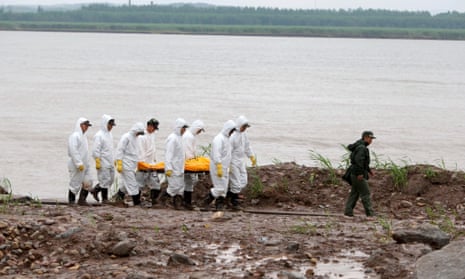
Families' anger grows after China cruise ship sinking
Chinese authorities appear nervous as families arrive in Yangtse riverside town after ship capsized carrying 456 people
Forty-eight hours after a Chinese cruise ship carrying 456 people capsized and sank on the Yangtze river, anger and frustration is growing among relatives of those feared to have died.
Dozens of family members arrived in Jianli on Wednesday, the town nearest to the disaster scene, seeking news of their loved ones.
By Wednesday night, just 40 of those travelling on the Eastern Star cruise ship had been accounted for – 14 survivors and 26 dead.
Liu Gang, whose 68-year-old mother is missing, told the Guardian he had arrived in Jianli with a group of about 20 other families in the early hours of Wednesday.
The group had hoped to visit the disaster site and accompany the rescue efforts. However, authorities prevented the families from reaching the site and had provided scant information about their operations, he complained.
“We are here but we still have to get all our information from the internet. We can’t go to the [disaster] site and have no way of finding out what has happened,” said Liu, whose mother, Shen Zhijuan, is still missing.
“We are prepared for the worst but [the government] should let us know what is really happening,” said a second relative – a 35-year-old from Shanghai who asked to be named only as Mr Gu and whose mother and father-in-law were on the ship. “Why they won’t talk to us?”
“Rescue crews in orange overalls began cutting a 55cm by 60cm hole in the ship’s hull on Wednesday night in the hope of finding further survivors inside, Xinhua, China’s official news agency reported.”
Earlier, navy divers had used their hands to feel their way through sections of the submerged vessel, Zhang Jianxin, a transport ministry official, told state-run CCTV.
Li Keqiang, the Chinese prime minister, urged rescue workers tocontinue their efforts despite the difficult conditions. “The whole nation is putting their hope on you,” he said, according to state media.
But while the Communist party has been keen to emphasise its swift response to the tragedy, both Liu and Gu said the government’s lack of transparency was fuelling suspicion among relatives.
“To be honest, we don’t trust all the official information that is being published,” said Gu.
“The families can remain calm for a day or two, but what if one day we are unable to take it any more?”
“I wonder why they won’t let us go to the site,” said Liu.
“We told them that if they were worried they could organise for us to go there, but they didn’t respond to our request. We came here on our own because we are anxious and sad. We want to see our families, and we are not here to cause trouble.”
“If they insist on not letting us in, we might think there could be flaws in their rescue efforts,” he added. “Otherwise, why are they so scared of us, the families, being there?”
Liu said he had not given up hope of finding his mother alive. “If she comes back safely, I will never let her go on tourism trips again,” he said.
However, at Jianli’s main funeral parlour authorities were preparing for the worst. Shen Yuanhai, the owner of a coffin factory in the neighbouring province of Henan, said he delivered four lorries to the funeral home on Wednesday, each stacked high with refrigerated caskets.
After being unloaded by a forklift truck, the coffins, which have transparent, flower-covered lids, were packed side-to-side into four halls where wakes will be held over the coming days.
Zou Jinlin, a 40-year-old local who was among crowds gathered at the Rongcheng Crematorium, said she would comfort relatives by telling them: “It was a natural disaster. It wasn’t human error.”
Her words echoed reports in China’s government-controlled media that have repeatedly pointed to a tornado or cyclone as the most likely cause of Monday’s disaster.
“Under the special circumstance of cyclone, the pressure on the one side of the boat went beyond the standard it was designed for, resulting in the overturning of the boat,” Zhong Shoudao, the president of China’s Chongqing Boat Design Institute, told a press conference, according to the Associated Press.
However, some relatives remain unconvinced by the official narrative. Liu Gang said he could not grasp how “such a big ship could turn upside down” in the river and why the 251ft-long Eastern Star appeared to have been the only ship affected by the storm.
“There were many other ships – big and small – and they were all fine. If it really was the bad weather, other ships would have been affected too,” he said.
Questions over whether human error could have played a role grew on Wednesday after the Wall Street Journal reported that the Eastern Star had been cited for “safety infractions” two years ago.
Safety inspectors in Chongqing had given the Eastern Star the green light as recently as last month, the People’s Daily, Beijing’s official mouthpiece newspaper, said.
Chinese authorities appear nervous about the potential for unrest as hundreds of grieving relatives flock to the riverside town. As well as the massive rescue operation, large numbers of security forces have descended on Jianli, setting up roadblocks at major intersections. Foreign and Chinese journalists have been prevented from independently travelling to the disaster site.
Attempts to interview relatives who had gathered outside Jianli’s main hospital were thwarted by government volunteers in red armbands. One family was ushered into a black sedan, apparently against their will, and driven away from reporters. “Too many journalists! You have to get into the car!” a government volunteer told them.
“We feel powerless as a member of the public, especially when government officials block the roads and do not allow us go to the site,” complained Liu.
For relatives thre two key questions remained: what had happened to their loved-ones and why.
“You tell me, how could such a horrible disaster happen?” Liu said.
Additional reporting by Luna Lin
- Asia Pacific

China cruise disaster: death toll passes 100 as relatives complain of harassment

Capsized Chinese ship righted: 97 bodies found, hundreds still missing

Chinese workers face grim task recovering bodies from Eastern Star


Death toll jumps to 65 after China river cruise capsize as rescuers slice hull

Hundreds of coffins prepared as China realises scale of cruise ship tragedy

Anger and resignation at scene of Chinese cruise ship sinking

Chinese rescuers pull 65-year-old woman from Yangtze cruise ship – video
Most viewed.

Neuron Launches Network APIs for the Maritime Industry
- April 9, 2024

Neuron announced that it’s making its network APIs available to maritime solution providers and app developers to enable application-driven quality of experience (QoE) on demand.
Neuron’s network APIs can reimagine connectivity and QoE for critical onboard services such as medical, disaster response, remote monitoring and management, the company said in a statement.
With Neuron’s network APIs, maritime solution providers and app developers can connect their apps Neuron Grid to request QoE on demand. When an app triggers a request, Neuron will use AI and machine learning to facilitate network changes and deliver the capacity the app needs, in real-time.
“Telecom network APIs are incredibly powerful, but they’ve always been focused on cellular, limiting their value for maritime companies that rely on LTE, satellite and Wi-Fi,” said Benny Retnamony, founder and CEO of Neuron. “Because Neuron enables multi-provider access with AI-powered network management, we are uniquely positioned to facilitate application-driven QoE on demand for the maritime industry. We look forward to collaborating with a range of maritime solution providers to unlock the next generation of apps and services at sea.”
In addition, Neuron has also announced a collaboration with VIKAND and FrontM to explore a variety of ways to transform onboard medical services across the maritime industry. With Neuron’s network APIs, VIKAND can ensure continuity of care even in emergencies, enabling doctors to use advanced digital imaging equipment right from the ship.
Cruise Industry News Email Alerts
- Breaking News
Get the latest breaking cruise news . Sign up.
54 Ships | 122,002 Berths | $36 Billion | View
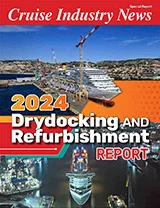
Highlights:
- Mkt. Overview
- Record Year
- Refit Schedule
- PDF Download
- Order Today

- 2033 Industry Outlook
- All Operators
- Easy to Use
- Pre-Order Offer
- Advertising
- Cruise News
- Magazine Articles
- Quarterly Magazine
- Annual Report
- Email Newsletter
- Executive Guide
- Digital Reports
Privacy Overview
Watch CBS News
Chinese cruise ship sinks
June 3, 2015 / 11:07 AM EDT / CBS News
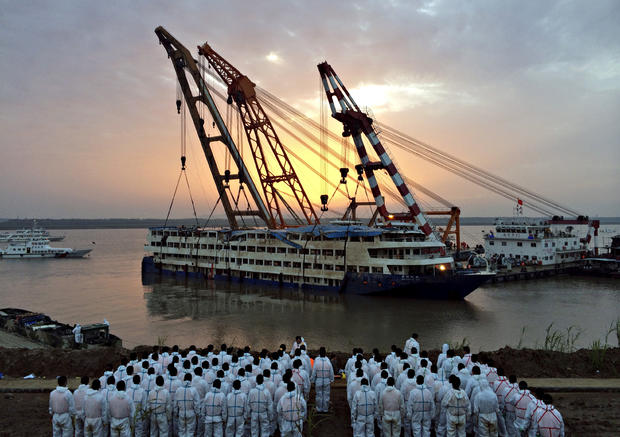
More than 200 divers combed a capsized Chinese ship in the Yangtze River looking for more than 450 missing people, many of them elderly Chinese tourists, when The Eastern Star sank in a heavy storm. Only 14 survivors, one of them the captain, have been found. A total of 103 bodies have been recovered.
The death toll climbed on Friday as authorities righted the battered vessel and turned their efforts to recovering bodies still on board amid simmering anger from distraught families.
In this photo, rescue workers stand on the river bank as The Eastern Star is pulled out of the Yangtze River at sunset in Jianli, China, June 5, 2015.
Chinese cruise ship righted

A rescue team works on lifting the capsized cruise ship The Eastern Star in the Jianli section of Yangtze River in China, June 5, 2015.

Rescuers stand by as the capsized cruise ship The Eastern Star is righted in the Yangtze River in China, June 5, 2015.

A rescue team works on righting the capsized cruise ship The Eastern Star in the Yangtze River in China, June 5, 2015.
Capsized Chinese cruise ship

An aerial view shows rescue workers standing on the sunken cruise ship The Eastern Star in Jianli, Hubei province, China, June 4, 2015.

Relatives of a missing passenger from The Eastern Star cry along the banks of the Jianli section of Yangtze River in Hubei province, China, June 4, 2015.
Hundreds of relatives of passengers gathered in a public square in Jianli on Thursday clutching candles and flowers, as rescue officials began the arduous task of righting the vessel.
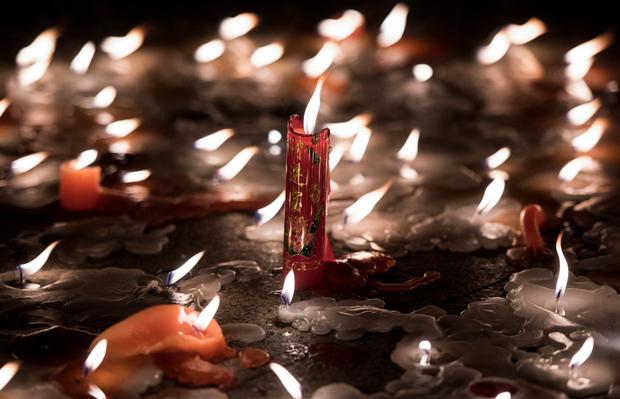
Candles burn during a vigil for the victims of the sunken ship in China's Hubei province, June 4, 2015.

Local residents take part in a candlelight vigil to pay their respects to victims of the sunken ship in Jianli, in China's Hubei province, June 4, 2015.
Distraught and angry relatives rushed to the site of the capsized cruise ship seeking news of their loved ones, as rescue workers recovered dozens of bodies.
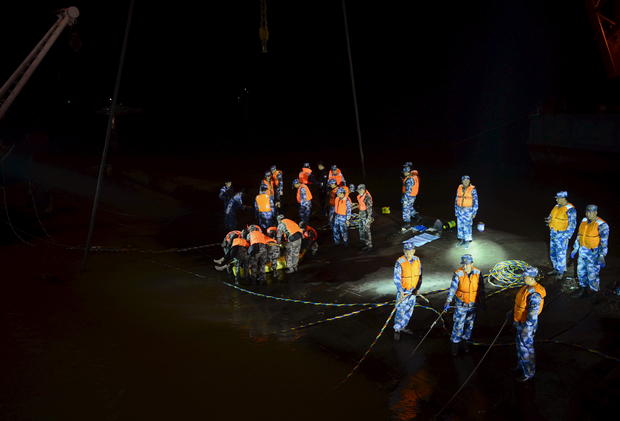
Rescue workers carry the body of a victim at the site where The Eastern Star capsized on Monday, in Jianli, Hubei province, June 4, 2015.

Students pray for passengers on the sunken cruise ship at a school in Zhuji, Zhejiang province, June 3, 2015.
Scores of divers cautiously searched a cruise ship in the Yangtze River on Wednesday for more than 400 missing people as the death toll in what could be China's worst shipping disaster in almost 70 years jumped to 18. The Chinese characters read "Pray for life", "Eastern Star".
Eastern Star
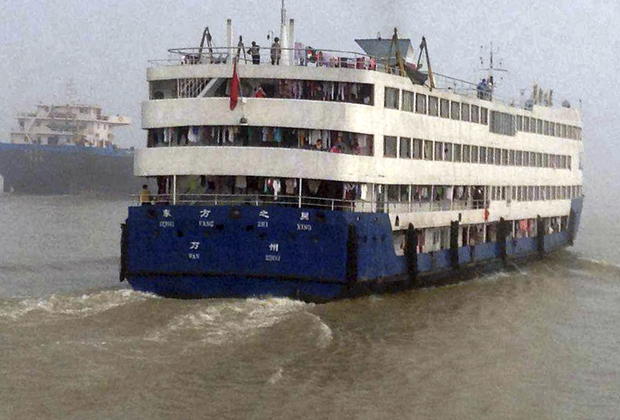
The sunken cruise ship Eastern Star is seen on the Yangtze River in this undated picture before it capsized in Jianli, Hubei province, China.
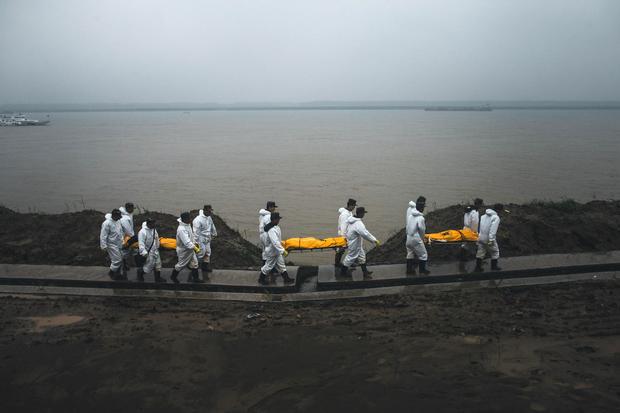
Rescuers carry bodies of the victims of the capsized Chinese cruise ship "Eastern Star" along the shore of the Yangtze River in Jianli, central China's Hubei province, June 3, 2105.

Paramilitary soldiers walk along the Yangtze River during their rescue work near the site of a capsized ship in Hubei province, China, June 3, 2015.

A rescuer stands next to the body of a victim of the capsized Chinese cruise ship, as rescue operations continue on the boat (top R) in Jianli, central China's Hubei province, June 3, 2015.
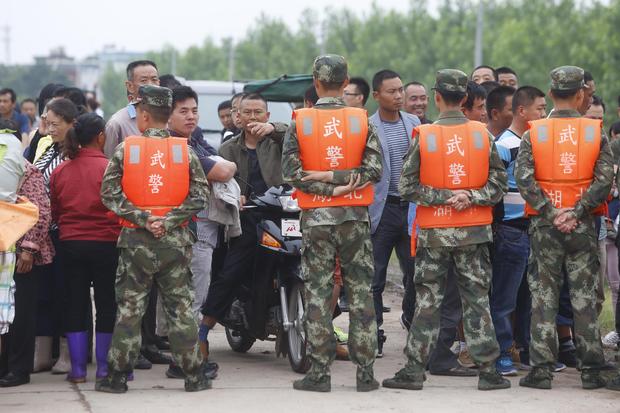
Chinese paramilitary soldiers restricting onlookers gathered near the site of a capsized Chinese cruise in China's Hubei province, June 3, 2015.
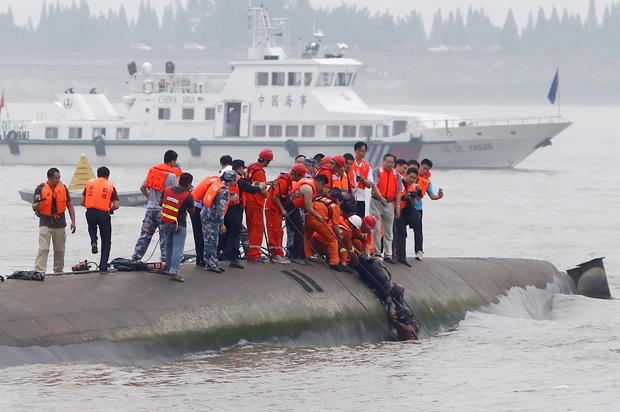
Here, a man is pulled out alive by divers and rescuers from the sunken ship at the Jianli section of the Yangtze River in Hubei province, China, June 2, 2015.

A relative of a passenger - missing after a Chinese cruise ship capsized on the Yangtze river - wipes away tears as families gather at the disaster site in Jianli, in central China's Hubei province, June 3, 2015.
China pledged there would not be a cover-up in an investigation into the sinking of the cruise ship as angry families gathered near the rescue site to demand answers.
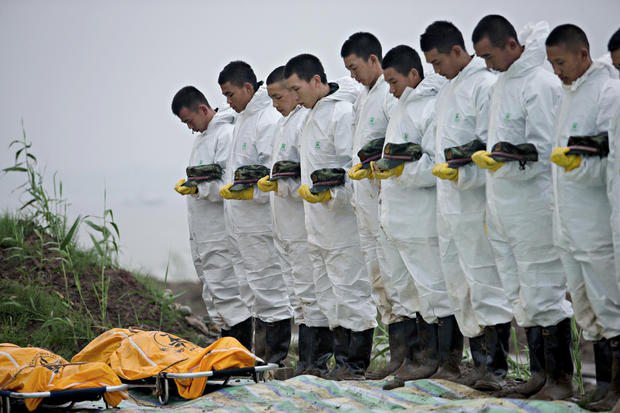
Rescue workers pay a silent tribute to the victims (wrapped in yellow) of the capsized Chinese cruise ship in Jianli, China, June 3, 2015.
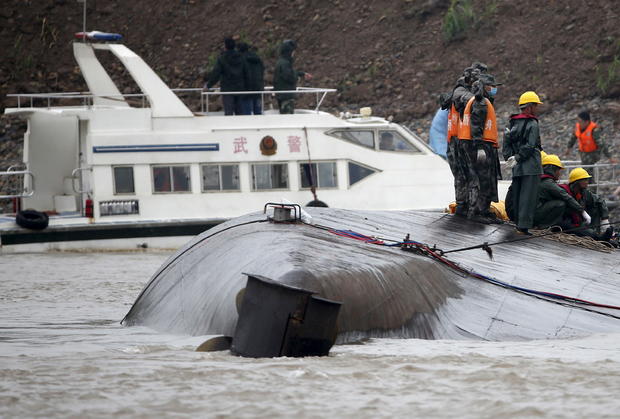
Rescue workers and a capsized ship in the Jianli section of the Yangtze River in China, June 3, 2015.
President Xi Jinping convened a special meeting of the ruling Communist Party's Politburo Standing Committee on Thursday to discuss the disaster, state news agency Xinhua said.
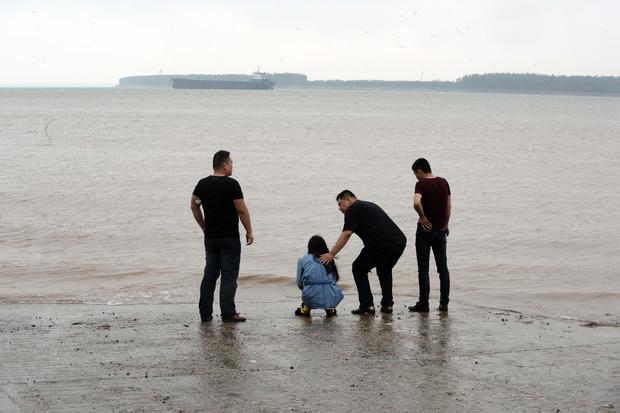
A relative of passengers on board the capsized ship Eastern Star being comforted is comforted by a man on the shore of the Yangtze River in Jianli, central China's Hubei province, June 3, 2015.
Relatives of more than 400 people missing after the cruise ship "Eastern Star" capsized in the Yangtze River gathered at the disaster site on June 4, as rescuers breached the hull in a last-ditch to rescue more of 400 people believed trapped inside.

Rescuers carry victims' bodies from the capsized ship Eastern Star in the Yangtze River in Jingzhou, China, June 3, 2015.

Local residents look at rescue operations for survivors of The Eastern Star in the Yangtze river in China's Hubei province, June 3, 2015.
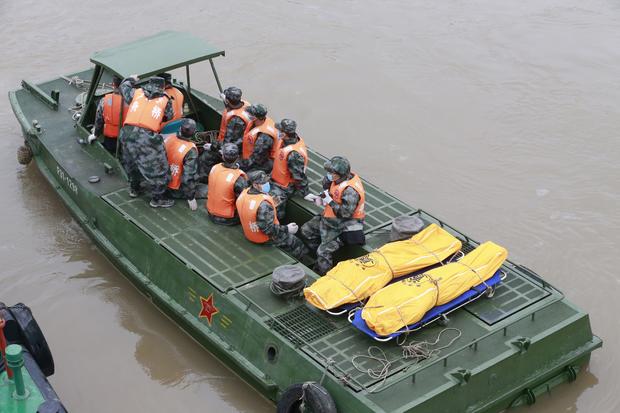
Rescue personnel transport remains of victims from the capsized passenger ship The Eastern Star in the Yangtze river in China's Hubei province, June 3, 2015.
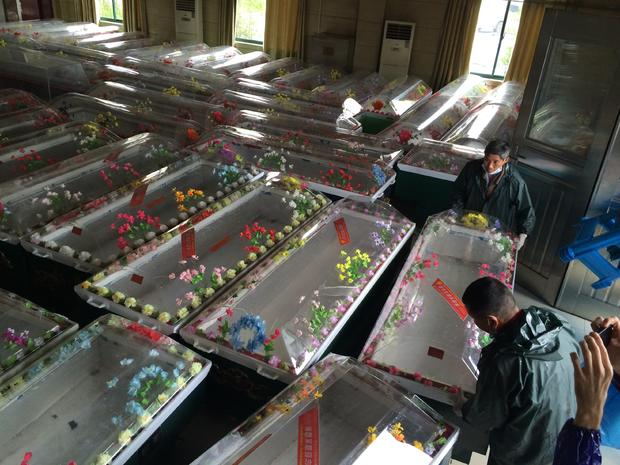
Workers prepare coffins for victims of the capsized ship at a funeral parlor in Jingzhou, China, June 3, 2015.
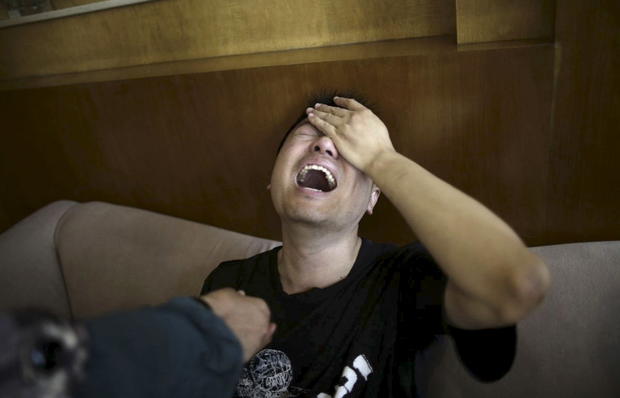
A family member of passengers on the sunken ship cries outside the closed office of Xiehe Travel in Shanghai, June 2, 2015.
Divers pulled an 65-year-old woman and two men from the hull of a passenger ship carrying 458 people that capsized on China's Yangtze River. Others could still be alive, state media said on Tuesday, in one of China's worst recent disasters.
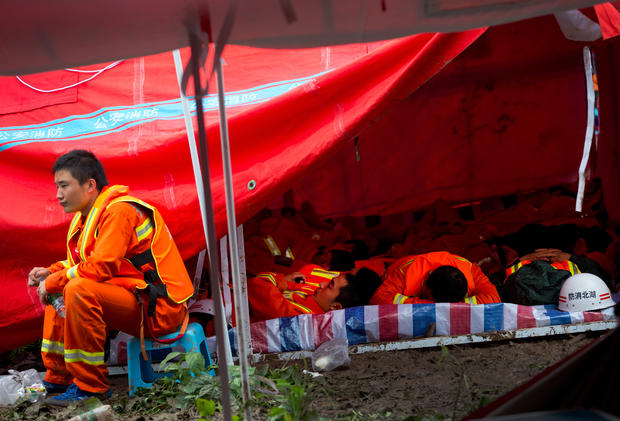
A rescuer takes a break near his napping colleagues at a command center set up for rescue operations for passengers of a capsized cruise ship on the Yangtze River in central China's Hubei province Wednesday, June 3, 2015. Hopes dimmed Wednesday for rescuing more of the people still trapped in the capsized river cruise ship that overturned in stormy weather, as hundreds of rescuers searched the Yangtze River site in what could become the deadliest Chinese maritime accident in decades.

Rescue workers are seen atop the sunken ship in the Jianli section of Yangtze River in China, June 3, 2015.

Divers help a 65 year-old woman to shore after she was pulled out from a sunken ship in Jianli, Hubei province, China, June 2, 2015.

Medical workers rush an injured sailor, from the sunken ship in the Yangtze River, for treatment upon arrival at a hospital in Jingzhou, Hubei province, China, June 2, 2015.
Rescuers fought bad weather on Tuesday as they searched for more than 400 people, many of them elderly Chinese tourists, missing after a ship capsized on the Yangtze River in what was likely China's worst shipping disaster in almost 70 years.

A relative of a missing passenger aboard a capsized cruise ship cries on the banks of the Yangtze River in Hubei province, China, June 3, 2015.
Scores of divers searched the capsized ship in the Yangtze River on Wednesday for more than 400 missing people, many of them elderly tourists, as the death toll in what could be China's worst shipping disaster in almost 70 years doubled to 14.

Chinese soldiers ride to the embankment after their search and rescue operation near a capsized cruise ship on the Yangtze River in central China's Hubei province, Tuesday, June 2, 2015.

A rescue ship and aid workers are seen around a sunken ship in the Jianli section of Yangtze River in China, June 2, 2015.

Rescue ships and workers are seen around a sunken ship in the Yangtze River in China, June 2, 2015.
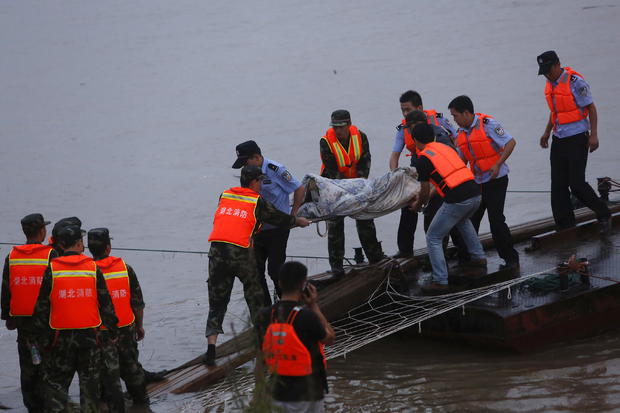
Rescue workers carry a body from the sunken ship in the Jianli section of Yangtze River in China, June 2, 2015.
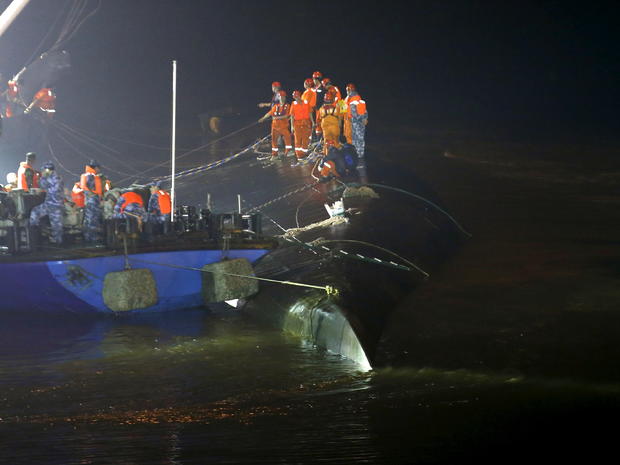
Rescue workers are seen atop a sunken ship in the Jianli section of Yangtze River in China, June 2, 2015.
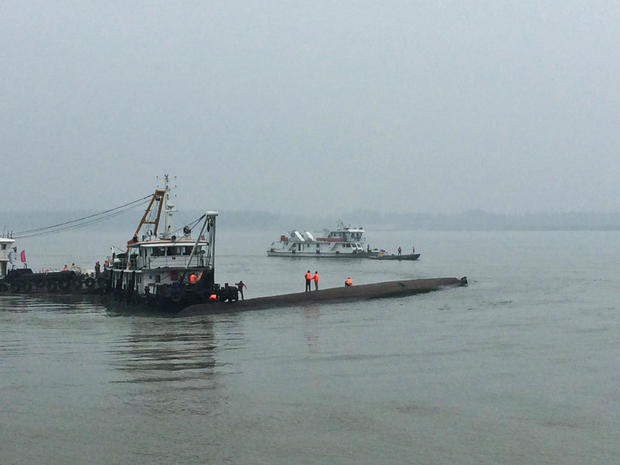
Rescue workers search the sunken ship in the Jianli section of Yangtze River, in Hubei province, China, June 2, 2015.
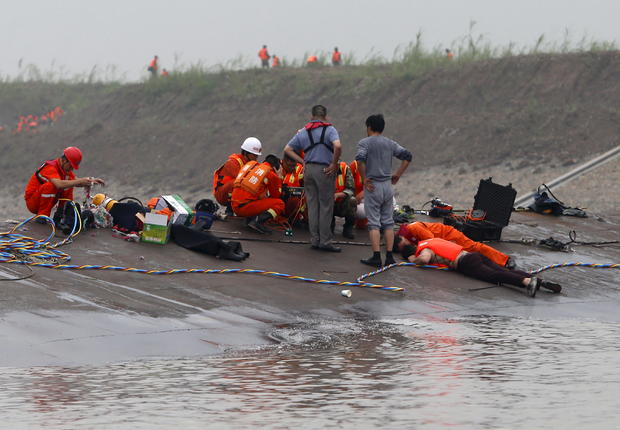
Rescuers listen for sounds from inside a sunken ship as they search for survivors at the Jianli section of the Yangtze River in China, June 2, 2015.
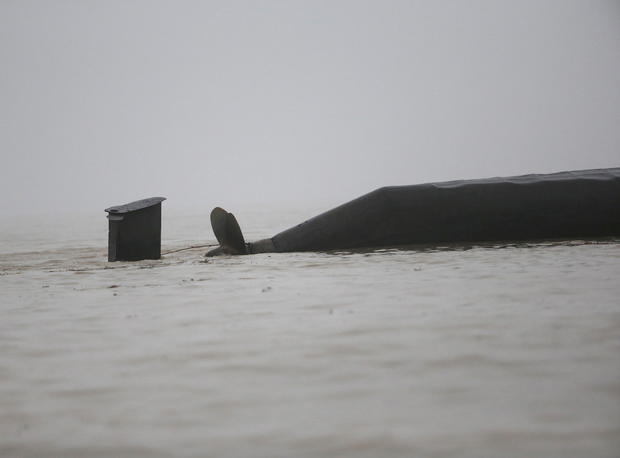
The sunken ship is seen in the Jianli section of Yangtze River in China, June 2, 2015.
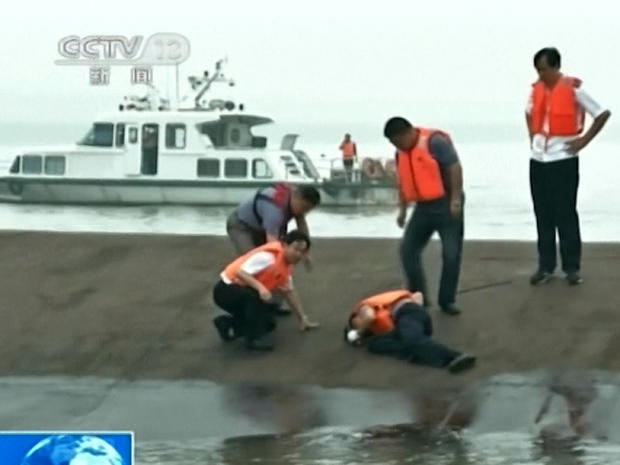
Rescue workers listen for a response to their tapping on the hull of a capsized ship on the Yangtze river in China, June 2, 2015.

COMMENTS
Sinking of MV Dongfang zhi Xing. / 29.7123; 112.9236. MV Dongfang zhi Xing ( Chinese: 东方之星; pinyin: Dōngfāng zhī Xīng; translated as Oriental Star or Eastern Star) was a river cruise ship that operated in the Three Gorges region of inland China. On the night of 1 June 2015, the ship was traveling on the Yangtze River when it ...
JIANLI, China --The death toll in the Eastern Star capsizing rose to 331 on Saturday as disaster teams searched the now-upright ship for more bodies, making it China's deadliest boat disaster in ...
Chinese cruise ship sinks 39 photos The capsizing late Monday of the multi-decked Eastern Star in the Yangtze River is on track to become the country's deadliest maritime disaster in seven decades.
Houthis vow to keep attacking ships after U.S., U.K. strikes in Yemen; U.S. warns against dating apps in Colombia after "suspicious deaths" Pro-Haley super PAC labels DeSantis a Trump "suck up"
Hundreds feared dead in cruise ship disaster. 01:50 ... Relatives of more than 400 people missing after a cruise ship capsized on China's Yangtze river were hoping for a "miracle" on June 3, as ...
Stuart Greer reports. JIANLI, China - Hopes dimmed Wednesday for rescuing more than 400 people still trapped aboard a capsized river cruise ship that overturned in stormy weather about 36 hours ...
Just offshore lay the upended shell of the Eastern Star, a luxury cruise ship that was carrying 458 people, including dozens of elderly tourists and a three-year-old boy, when it capsized and sank ...
BEIJING (AP) — China has assembled a team of 60 investigators to look into last week's river cruise ship sinking following orders from President Xi Jinping to find the cause of the country's worst maritime disaster in nearly seven decades. Just 14 people survived the capsizing of the Eastern Star on the evening of June 1 as the ship was carrying 456 people, many of them elderly tourists, on ...
Lily Kuo. Published June 5, 2015. Chinese rescuers do not expect to find any more survivors from a capsized cruise boat on the Yangtze River. The death toll is expected to reach over 440 people ...
Jianli County, China CNN —. With hopes fading of finding survivors, Chinese rescuers are cutting holes in the hull of the capsized cruise ship in the Yangtze River. So far, they haven't found ...
The death toll from the Yangtze river cruise disaster has risen to 103 as authorities commemorate successfully lifting the wreckage ... Anger and resignation at scene of Chinese cruise ship sinking.
Ship sinks in China's Yangtze River. 1 of 24. Fourteen people have survived the disaster, a number that has barely changed since Tuesday, the day after the Eastern Star capsized during a storm on ...
Last modified on Fri 5 Jun 2015 00.50 EDT. Top-deck cabins poked out of the water from a capsized river cruise ship on the Yangtze on Friday after disaster teams righted the vessel to quicken the ...
Chinese authorities escalated efforts to recover more than 420 people believed to be trapped inside an overturned river cruise ship Wednesday, deploying scores more divers and a large crane to ...
Police carry a body to the shore of the Yangtze River in Nanjing, China, on Tuesday, June 9. The Eastern Star cruise ship sank late Monday, June 1, in stormy weather, with more than 450 passengers ...
After a six-month investigation, China has concluded that strong storms caused the sinking of the cruise ship Eastern Star in the Yangtze River in early June that killed 442 people. Authorities ...
Hundreds missing after cruise ship capsizes in China 01:28. BEIJING --Rescuers pulled out survivors after hearing cries for help Tuesday from inside a capsized cruise ship on China's Yangtze River ...
An official inquiry has found that a freak storm caused the sinking of a cruise ship on China's Yangtze river with the death of nearly 450 people and recommended the captain be investigated for ...
The deadliest crash took place in 1983, when a passenger ship collided with a railroad bridge on the Volga River in Russia, killing 176 people, according to the report.
An image of a chain link. It symobilizes a website link url. Copy Link A Bulgarian cruise ship carrying over 140 passengers crashed into a concrete wall along the Danube river in Austria. The ...
Chinese cruise ship sinks 39 photos. JIANLI, China -- Rescuers cut into the upside-down hull of a river cruise ship and pulled out dozens of drowned passengers early Thursday, bringing the death ...
The owner and manager of a cargo ship that rammed into Baltimore's Francis Scott Key Bridge before the span collapsed last week filed a court petition Monday seeking to limit their legal liability for the deadly disaster.. The companies' "limitation of liability" petition is a routine but important procedure for cases litigated under U.S. maritime law.
Forty-eight hours after a Chinese cruise ship carrying 456 people capsized and sank on the Yangtze river, anger and frustration is growing among relatives of those feared to have died. Dozens of ...
Police carry a body to the shore of the Yangtze River in Nanjing, China, on Tuesday, June 9. The Eastern Star cruise ship sank late Monday, June 1, in stormy weather, with more than 450 passengers ...
Neuron's network APIs can reimagine connectivity and QoE for critical onboard services such as medical, disaster response, remote monitoring and management, the company said in a statement. With Neuron's network APIs, maritime solution providers and app developers can connect their apps Neuron Grid to request QoE on demand.
Capsized Chinese cruise ship AFP/Getty Images A relative of a passenger - missing after a Chinese cruise ship capsized on the Yangtze river - wipes away tears as families gather at the disaster ...